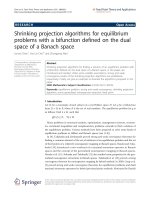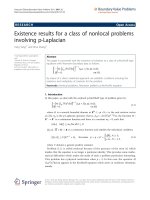Fredholm alternative for the second order differential opertor associated to a class of boundary conditions
Bạn đang xem bản rút gọn của tài liệu. Xem và tải ngay bản đầy đủ của tài liệu tại đây (149.57 KB, 11 trang )
Fredholm alternative for the second order differential opertor associated
to a class of boundary conditions
Do Huy Hoanga , Le Xuan Truonga,∗
a
Department of Mathematics and Statistics, University of Economics HoChiMinh city,
59C, Nguyen Dinh Chieu Str, District 3, HoChiMinh city, Vietnam
Abstract
This work is concerned with the Fredholm property of the second order differetial opertor associated to a class of boundary conditions. Several sufficient conditions will be proved along with
constructing the generalized inverse for such operator. The result is a basic tool to analysis the
boundary value problems at resonance for nonlinear perturbation of such operators.
Keywords: Fredholm property, second order differential operator, continuation theorem,
projector, generalized inverse
2010 MSC: 34B10, 34B15
1. Introduction
The question of the solvability for nonlinear pertubation of differential operators associated to
multi-point or nonlocal boundary conditions have been extensively studied. To indentify a few, we
refer the reader to [1]-[12] and references therein. Almost such problems, written in operator form,
is of the type
x = N x,
(1.1)
where
is a linear mapping between two Banach spaces X and Z, while N : X → Z is a nonlinear
mapping. Studying problem (1.1) is often confronted with the difficulty that the relevant linearized
operator is not invertible in suitable function spaces. There have been some methods to overcome
this obstacle as the alternative method [1, 12], the pertubation method (the name was proposed
by Kannan [7]) or continuation method of Mawhin [4],...
One of important hypotheses of Mawhin’s continuation theorem that is the Fredholm of index
zero property of linear operator L which mean that
(i) ker
has finite dimension,
(ii) Im
is a closed subset of Z and has finite codimension.
(iii) ind
= dim ker
− codim Im
= 0.
In many papers (see [2, 3, 5], [8]-[11]), this property is often proved by constructing first a continuous projector Q : Z → Z which satisfies the condition ker Q = Im . And then it follows that
Im
has finite codimension as well as index of
is equal to 0. Nevertheless it seems that the
construction a such projector is difficult when dim ker
is large ([8]-[11]). So looking for the
sufficient conditions to ensure Fredholmness of
is still quite limited.
∗
Corresponding author
Email address: ❧①✉❛♥tr✉♦♥❣❅❣♠❛✐❧✳❝♦♠ (Le Xuan Truong )
Preprint submitted to Elsevier
November 12, 2014
The goal of current paper is to study the differential operator
x(t) =
where X := C 1 [0, 1];
dom
d
=
, Z := L 1 (0, 1);
d t2
d
x ∈ X , x ∈ Z and
d2 x
: dom
⊂ X → Z defined by
(t) = x (t),
endowed with their usual norms and
Ax(0) + B x (0) = D
1
0
x(s)ds
E x(1) + F x (1) = G
1
0
x(s)ds
,
with A, B, D and E, F , G are square matrices of order d. Our results mentioned two issues. The
first is looking for conditions of coefficient matrices for which the operator
is Fredholm of zero
index (section 2) and the second is characterizing the set of all right-hand side functions y ∈ Z for
which the equation x = y has at least one solution x ∈ dom (section 3).
To the best of our knowledge, the above issues has not been developed in general cases of
dimension of the kernel. Furthermore our method involves several new ideas and gives a unified
method of attack for many boundary value problems at resonance. Previous paper dealt with one
problem at a time whereas our method allows us to solve many problem at once.
We end this section by noting that our results can be used to discuss the solvability of equation
x(t) = f t, x(t), x (t) , t ∈ (0, 1),
on dom by using the Mawhin’s continuation theorem. This can be done by standard arguments
(see [4, 8, 11]). However we will not state here.
2. Fredholm property of the operator
In the rest of paper we use the following notations
is zero matrix of order d × d and θ is zero element of
d
.
Id : the identity matrix of order d.
ν
z(t) :=
t
(t
0
− s)ν−1 z(s)ds, for all z ∈ Z and ν ∈ {1, 2}.
First it’s necessary to note that, for x ∈ dom
So, when x ∈ dom
, we can write
x(t) = x(0) + x (0)t + 2 x(t).
Ax(0) + B x (0) = D
, the boundary conditions
E x(1) + F x (1) = G
x(0), x (0)
where
•
=
A− D
E−G
B − 12 D
E + F − 12 G
2
T
=
(
x) ,
(2.2)
1
0
x(s)ds
1
0
x(s)ds
are equivalent to
(2.3)
•
:Z→
2d
is a continuous linear mapping defined by
(z) = D
1
1
2
2
z(t)d t , G
0
0
z(t)d t − E z(1) + F z(1) , z ∈ Z.
2
1 (z)
Therefore dom
dom
1
(2.4)
2 (z)
can be represented as follows
=
x(t) = x(0) + x (0)t +
2
x(0)
x (0)
x(t), t ∈ [0, 1] :
=
(
x) .
Lemma 2.1. We have
ker
and Im
∼
= Ker
= x ∈ X : x(t) = c0 + c1 t, t ∈ [0, 1], c0 , c1 ∈ ker
= {z ∈ Z :
(z) ∈ Im
,
}.
Proof. The proof of this Lemma is straightforward and we will omit the details.
Theorem 2.1. The operator
• zero if dim (Im
+ Im
• positive if dim (Im
is Fredholm. Moreover the index of
is
) = 2d.
+ Im
) < 2d.
To prove this Theorem we need the following lemma
Lemma 2.2. Let E, F be two vector spaces on field , be a linear operator from E into F . Assume
that be a subspaces of F . If
is an algebraic complement of −1 ( ) in E then
is isomorphic
to any algebraic complement of ∩ (E) in (E).
Proof. Let
be the restriction of
on . Since −1 (0) ⊂
∩ −1 ( ) = {0} it is easy to see
that
is an isomorphism from
into ( ) which means that
is isomorphic to ( ). So it
is sufficient to show that
( ) ≡ ( ) is an algebraic complement of := ∩ (E) in (E).
Indeed, for any y ∈
(E), there exist x 1 ∈
y=
−1
( ) and x 2 ∈
x1 +
such that
x2.
Since x 1 ∈
and x 2 ∈ ( ) the above equality implies that (E) = + ( ). On the
other hand, if y0 ∈
∩ ( ) then y0 = (x 0 ), where x 0 ∈ −1 ( ) ∩
= {0}. Therefore
y0 = (0) = 0. This implies ∩ ( ) = {0}. So (E) = ⊕ ( ). The proof of Lemma is
complete.
Proof of Theorem 2.1 Since
is continuous from Z into 2d and Im
is closed in 2d it is clear
that Im is a closed subspace of Z. Further we have dim ker = dim ker
< ∞. So it remains to
show that codim Im = dim ker . Indeed, by using Lemma 2.2, if Z0 is an algebraic complement
of Im in Z then Z0 isomorphic to any algebraic complement of Im ∩ Im in Im . So
codim Im
= dim (Z/ Im
) = dim Z0
= dim (Im
/ (Im
= dim Im
− dim (Im
= dim (Im
3
+ Im
∩ Im
))
∩ Im
) − dim Im
)
This implies that codim Im < ∞ and so
proof of Lemma is complete.
is a Fredholm operator. The remains is evident. The
Next we will provide some sufficient conditions for
need the following lemma:
Lemma 2.3. The image of
can be defined by
=
Im
Dα, Eβ + F γ + Gα ∈
Consequently, if Im G ⊂ Im E + Im F then Im
Proof. Recall that
(z) =
1 (z)
1 (z),
2 (z)
1
t
= D
= G
d
×
d
d
: α, β, γ ∈
.
= Im D × (Im E + Im F ).
, where
(t − s)z(s)ds,
dt
0
1
2 (z)
to be Fredholm of zero index. First we
0
1
t
(t − s)z(s)ds − E
dt
0
0
1
(1 − s)z(s)ds − F
z(s)ds.
0
0
Clearly it’s suffit to prove the inclusion supset (⊃). Let (ξ, ζ) be an element of the set
d
Dα, Eβ + F γ + Gα ∈
d
×
d
: α, β, γ ∈
.
Then we can write ξ = Dα1 , and ζ = Eα2 + F α3 + Gα1 , where αi = αi1 , αi2 , ..., αid ∈
consider the function
z(t) = z1 (t), z2 (t), ..., zd (t) , t ∈ [0, 1],
d
. We
where z j (t) = a j + b j t + c j t 2 with the coefficients a j , b j , c j be choosen such that
1
dt
0
t
(t
0
− s)z(s)ds = α1 j ,
1
(1 − s)z j (s)ds
0
1
z (s)ds
0 j
= −α2 j ,
= −α3 j .
It is note that by some simple calculations we can see that the above system of linear equation has
1
t
a unique solution. Hence we can deduce that ξ = D 0 d t 0 (t − s)z(s)ds = 1 (z) and
1
ζ=G
1
t
which implies (ξ, ζ) ∈ Im
. So
=
Im
2 (z),
0
0
0
z(s)ds =
(1 − s)z(s)ds − F
(t − s)z(s)ds − E
dt
0
1
Dα, Eβ + F γ + Gα ∈
d
×
d
: α, β, γ ∈
d
.
Now assume that Im G ⊂ Im E+Im F . If (ξ, ζ) ∈ Im D×(Im E + Im F ) then there exist α, β, γ ∈
such that
ξ = Dα and ζ = Eβ + F γ.
On the other hand, it’s clear that there are α1 , α2 ∈
d
d
such that Eα1 + F α2 = Gα. So we can write
ξ = Dα and ζ = E β − α1 + F γ − γ2 + Gα,
which implies (ξ, ζ) ∈ Im
has been proved.
. Hence it is easy to see that Im
4
= Im D × (Im E + Im F ). The Lemma
Corollary 2.1. The operator
holds
is Fredholm of zero index provided that one of following conditions
(a) det(D) = 0 and det(E) = 0,
(b) det(D) = 0 and det(F ) = 0,
(c) det(D) = 0 and det(E + F ) = 0,
Proof. Using lemma 2.3 it’s easy to prove that if one of above conditions holds then Im
So by theorem 2.1
is a Fredholm of zero index operator.
Corollary 2.2. The operator
hold
(a) 2B = D, det E + F −
G
2
=
2d
.
is Fredholm of zero index provided that one of following conditions
= 0, and Im(A − D) + Im D =
d
,
(b) det(A − D) = 0 and one of determinants det(E), det(F ), det(E + F ) is not equal to zero,
(c) det(2B − D) = 0 and one of determinants det(E), det(F ), det(E + F ) is not equal to zero.
Proof. (a) In this case it’s clear that Im
2.3 we get
Im + Im
and so dim (Im
+ Im
= Im(A− D)×
d
. By combining this equality and lemma
d
= (Im(A − D) + Im D) ×
) = 2d. From theorem 2.1 we deduce that
+ Im
(b) We will check that Im
=
d
×
d
. Indeed, for u, v ∈
is Fredholm of zero index.
d
, the system
(A − D)x + B − 21 D y + Dα = u
(E − G)x + E + F − 12 G y + Gα + Eβ + F γ = v
has at least one solution defined by x = (A − D)−1 u, y = α = 0 and
if det(E) = 0,
β = E −1 (v − (E − G)x) , γ = 0,
−1
β = 0, γ = F (v − (E − G)x) ,
if det(F ) = 0,
β = γ = (E + F )−1 (v − (E − G)x) , if det(E + F ) = 0.
This show that (u, v) ∈ Im + Im
zero index by using theorem 2.1.
which implies Im
+ Im
=
d
×
d
. So
is Fredholm of
(c) This case can be proved similarly.
Remark 2.1. By using lemma 2.3 and the analysis of matrix
conditions which are similar the corollaries 2.1 and 2.2.
we can obtain some various sufficient
3. The generalized inverse of operator
Assume that dim (Im + Im ) = 2d. It follows from Theorem 2.1 that there exist continuous
projectors P : X → X and Q : Z → Z such that
Im P = Ker
,
KerQ = Im
Moreover the restriction of
on dom
Im . Then the generalized inverse of
,
X = Ker
⊕ KerP,
Z = Im
⊕ Im Q.
∩ ker P, P , is an isomorphism from dom
is defined by P,Q = P−1 (I − Q).
5
∩ ker P onto
The construction such projectors as well as the generalized inverse of
study the linear equation
x = y,
is very important to
on dom as well as the correspondent nonlinear boundary value problems at resonance by using
the Mawhin’s continuation theorem (see [4, 8, 10, 11] and references therein). In the following we will present a general way to construct the projectors Q, P and pseudo inverse P,Q . For
this aim we denote the orthogonal complement of Im
∩ Im
in Im
by Σ and assume that
ei : i = 1, 2, ..., m is an its basis. Denoted by
the matrix whose jth column is e j . It is well
known that
−1
T
T
P =
is the orthogonal projection matrix with Im P = Σ.
2
In order
to construct the projector Q we first note that if z = c0 + c1 t + c2 t then
c0
c1 , where
c2
D/6
D/24
D/60
=
G/6 − E/2 − F G/24 − E/6 − F /2 G/60 − E/12 − F /3
(z) =
By some lengthy calculations we can prove the equality Im = Im . On the other hand it’s clear
that the restriction ∗ of on the orthogonal complement ker ⊥ of ker is an isomorphism from
ker ⊥ onto Im . For i = 1, 2, ..., m, we put
ωi (t) = ω0i + ω1i t + ω2i t 2 , where ω0i , ω1i , ω2i =
and consider the subspace Z0 of Z which is spanned by the vectors ωi
dim Z0 = dim (Im
∩ Im
)⊥ = dim Im
We can also show that Z0 is an complement of Im
z ∈ Im
⇔
− dim (Im
−1
∗ ei ,
m
.
i=1
Then it’s evident that
) = dim ker
∩ Im
.
in Z. Moreover,
z, ei = 0, ∀i ∈ {1, 2, ..., m}.
Now we define the linear map Q : Z → Z by
m
Q(z) =
λi ωi (t), ∀z ∈ Z,
(3.5)
i=1
where (λ1 , λ2 , ..., λm ) is the unique solution of the system linear equation
not difficult to prove that Q is a continuous projector on Z and
Im Q = Z0 ,
ker Q = Im
and
Z = Im
−1
P .
Now we shall construct the projector P and the map
doinverse of . For x ∈ X we put
P x = (1, t) I2d −
+
T
=P
(z). It’s
⊕ Im Q.
+
Let
x(0), x (0)
m
i=1 λi ei
T
,
is the Moore-Penrose pseu(3.6)
Here if α, β ∈ d × d then the notation (1, t) α, β stand for α + β t. Since I2d − +
is
an orthogonal projector on ker
it’s not difficult to check that P is a continuous projector on X .
Furthermore we have
Im P = ker , X = ker ⊕ ker P.
6
Lemma 3.1. The operator
∩ ker P is invertible and its inverse
on dom
−1
P z(t)
+
= (1, t)
(z)) T +
(
2
z(t), t ∈ [0, 1],
−1
P
Moreover, there exists positive constant C such that
−1
P z
Proof. Let z ∈ Im
z ∈ Im
is defined by
.
(3.7)
satisfies the following estimate
≤ C z , ∀z ∈ Im
.
(3.8)
then it follows from (3.7) that
−1
P z(0), (
−1
P z
Hence it follows that P
we obtain
−1
P z
∈ dom
T
=
(
T
.
(3.9)
∈ ker P. Moreover by combining (3.7) and (3.9)
(0)
x(t) = (1, t)
for all t ∈ [0, 1]. Since x ∈ dom
(z)
T
+
=
−1
P is well-defined.
−1
P z(t) = z(t), for all
and so
−1
P
+
(0) =
−1
P z
−1
P z
On the other hand it’s clear that
x ∈ dom ∩ ker P then we have
x(0), x (0)
−1
P z)
= θ , that is,
−1
P z(0),
This show that
−1
P
+
(
(z) =
t ∈ [0, 1] and z ∈ Im
2
x) +
(z).
. Moreover, if
(3.10)
x(t)
∩ ker P it follows that
x)
−1
P
By combining (3.10), (3.11) we get
+
and
x(0), x (0)
T
= x(0), x (0)
T
.
(3.11)
x(t) = x(t), ∀t ∈ [0, 1].
Finally, by using (3.7) and the continuity of
of Lemma is complete.
we can obtain the estimate (3.8) and the proof
The main result is presented as below. Its proof is directly corollary of above analysis.
Theorem 3.1. Let
= z∈Z:
(i) no solution if y ∈
/
(z), ei = 0, ∀i ∈ {1, 2, ..., m} . The the equation
x = y has
,
(ii) at least one solution defined by x =
−1
P ( y)
if h ∈
.
4. Examples
This section presents some examples which is to illustrate our results.
Example 4.1 (Second order differential operators with Sturm-Liouville type conditions). Let d = 1
and
A = α, B = β, E = γ, F = δ and D = G = 0,
where α, β, γ, δ are real numbers which satisfy the conditions γ2 + δ2 = 0 and α(γ + δ) = βγ. We
have
α
β
and
z = 0, −γ 2 z(1) − δ 1 z(1) .
=
γ γ+δ
Without loss of generality we can assume γ = 0. Then it’s not difficult to prove that
Im
= {0} × ,
Ker
=
−
γ+δ
γ
ξ, ξ : ξ ∈
7
and
Im
=
ζ,
α
γ
ζ :ζ∈
.
This implies dim (Im
+ Im
) = 2 and so
Next we note that Σ = Im = {0} ×
on Im . On the other hand, since
has a basis {e1 = (0, 1)} and P
0
0
0
−ρ1 −ρ2 −ρ3
=
with ρ1 =
γ
+ δ, ρ2 =
2
γ
6
+
δ
2
, ρ3 =
γ
6
and
−1
∗
: {0} ×
⊥
→ ker
formula
δ
2
is the identity mapping
,
, we can show easily that
= λ ρ1 , ρ2 , ρ3 : λ ∈
,
defined by
−1
∗ (0, ζ)
Hence ω1 (t) = −
+
⊥
ker
is Fredholm operator of zero-index by theorem (2.1).
ρ1 + ρ2 t + ρ3 t 2
=
−ζ
ρ12
ρ1 , ρ2 , ρ3 , ∀ζ ∈ .
+ ρ22 + ρ32
, for all t ∈ [0, 1]. So the projector Q be defined by following
ρ12 + ρ22 + ρ32
γ 2 z(1) + δ 1 z(1)
Qz(t) =
ρ12 + ρ22 + ρ32
+
Now it’s not difficult to show that
ρ1 + ρ2 t + ρ3 t 2 .
0 γ−1
0 0
=
+
and I2 −
=
0 γ−1 (γ + δ)
0
1
. By
using (3.6) we can define the projector P by
P x(t) = x (0) −
Moreover, since
(z) = (0, 0) for all z ∈ Im
γ+δ
γ
+ t , ∀t ∈ [0, 1].
it follows from lemma 3.1 that
t
−1
P z(t)
(t − s)z(s)ds, t ∈ [0, 1], z ∈ Im
=
.
0
From above analyses we get
Claim 1. The equation
x = y has at least one solution defined by
t
−1
P y(t)
x(t) =
=
(t − s) y(s)ds, t ∈ [0, 1]
0
if and only if
1
γ
1
(1 − s) y(s)ds + δ
0
y(s)ds = 0.
0
Example 4.2 (Second order differential operators with nonlocal boundary conditions). Let
A= D = F =
and B = E = G = Id .
1
Id
1
1
and (z) = 0,
1
=
s2 z(s)ds −
Id
2 0
2
2
In this case we have
1
z(s)ds . It is easy
0
to prove that
Im
= {θ } ×
d
,
Ker
=
d
× {θ }
8
and
Im
= {(2ξ, ξ) : ξ ∈
d
}.
Since dim (Im
zero-index.
+ Im
) = 2d it follows from Theorem 2.1 that the operator
Next it’s easy to see that Σ = Im
simple calculations we obtain
and P
=
⊥
ker
and
−1
∗
: {θ } ×
d
⊥
→ ker
=
is the identity mapping on Im
I
I
− 3d
α,
defined by
− 15d
3α α
∈
,
8 5
3d
+
4800
1889
2 (z)
1+
d
:α∈
,
=−
3 1
α, α, α . So by using (3.5) we
1889
8 5
3
1
−1
∗ (θ , α)
get the formula of projector Q as follow
Qz(t) = −
. Further by some
,
I
− 8d
is Fredholm of
8
t+
4800
5
t 2 , t ∈ [0, 1].
we can deduce that P x(t) = x(0) for all t ∈ [0, 1].
Id
Further it follows easily from Lemma 3.1 that
On the other hand since
=
t
−1
P z(t)
(t − s)z(s)ds, t ∈ [0, 1], z ∈ Im
=
.
0
Finally we obtain the following result
Claim 2. The equation
if
x = y has at least one solution given by x(t) =
t
(t − s) y(s)ds
0
if and only
1
1
2
y(s)ds = 0.
s y(s)ds −
0
0
Example 4.3. Let following matrices
Λ1 =
Consider the operator
In this case we have
1 0
0 2
Λ2 =
,
on dom
1 2
3 4
,
Λ3 =
1/2 2
2 3
.
with
A = E = G = Λ1 , B = Λ2 , F = Λ3 , D = .
1 0 1 2
0
0 2 3 4
0
=
and (z) =
, where z(t) = z1 (t), z2 (t)
0 0 1 2
φ(z)
0 0 2 4
ψ(z)
and
φ(z) =
1
1
1
2
s z1 (s)ds −
2
1
z1 (s)ds − 2
0
0
1
0
z2 (s)ds,
0
1
s2 z2 (s)ds − 2
ψ(z) =
1
z1 (s)ds − 4
0
It’s not difficult to show that
• ker
and
= {λ(0, −1, 2, −1) : λ ∈ },
9
z2 (s)ds.
0
• Im
= (α, β, γ, 2γ) : α, β, γ ∈
• Im
= {(0, 0)} ×
2
,
.
Since Im ∩ Im
= (0, 0, γ, 2γ) : γ ∈
Fredholm of zero index.
it follows that dim (Im
+ Im
) = 4 and
so is
Construction of the projector Q:
• The orthogonal complement of Im ∩ Im in Im is Σ =
of this subspace is e1 = (0, 0, −2, 1) , and so we get
0 0 0
0
0 0 0
0
P =
4
2 .
0 0
−
5
5
1
2
0 0 −5 5
•
0
0
0
0
=
− 5 −2
6
−2 − 11
3
• ker
⊥
−1
∗
−1
∗
. A basis
0
0
− 32
17
− 15
has a basis as follow
1
•
0
0
0
0
0
0
7
− 38 −1 − 30
−1 − 74 − 23
0, 0, −2γ, γ : γ ∈
5
3
7
2
= − , −2, − , −1, − , −
,
6
8
30 3
: {(0, 0)} ×
2
0, 0, α, β =
→ ker
⊥
ω1 (t) =
11
7 2 17
, −1, − , − , −
3
4 3 15
.
defined by
1204545600
119586041
• the formula of projector Q:
= −2, −
2
α−
623952000
119586041
β
1+
−
623952000
119586041
α+
328352400
119586041
Qz(t) = − 52 φ(z) + 15 ψ(z) ω1 (t), for all z ∈ Z, where
− 624976800
119586041
286479600
119586041
+
− 25815600
7034473
274954500
119586041
343127520
− 119586041
t+
235604880
119586041
t 2.
Construction of the projector P: It is noted that
1 0
−1 0
0 1/2 −3/2 0
+
=
.
0 0
1
0
0 0
0
0
For x(t) = (x 1 (t), x 2 (t)), t ∈ [0, 1] we have
P x(t) = x 2 (0)
0
1
+
−2
1
t .
The generalized inverse: By the same arguments as above examples we have
P z(t)
= φ(z)
−1
−3/2
+
1
0
t
t +
(t − s)z(s)ds, t ∈ [0, 1], z ∈ Im
0
10
.
β
2
Claim 3. The equation
x = y with y(t) = y1 (t), y2 (t) , has at least one solution given by
t
x(t) =
φ( y)(−1 + t) + 0 (t − s) y1 (s)ds
t
− 32 φ( y) + 0 (t − s) y2 (s)ds
, t ∈ [0, 1]
if and only if
1
s2 y2 (s) − y1 (s) ds = 0.
0
Acknowledgments
This work was completed while the second author were visiting the Vietnam Institute for Advanced Study in Mathematics (VIASM).
References
[1] L. Cesari, Functional analysis, nonlinear differential equations and the alternative method, Proc.
Conf., Mich. State Univ., East Lansing, Mich., 1975, pp. 1-197.
[2] W. Feng and J. R. L. Webb, Solvability of three-point boundary value problems at resonance,
Nonlinear Analysis TMA, 30(6), (1997), 3227-3238.
[3] W. Feng, J. R. L. Webb, Solvability of m-point boundary value problems with nonlinear growth,
J. Math. Anal. Appl. 212 (1997), 467–480.
[4] R. E. Gaines, J. Mawhin, Coincidence Degree and Nonlinear Differential Equations, vol. 568,
Lecture Notes in Math., Springer-Verlag, Berlin, 1977.
[5] C. P. Gupta, Existence theorems for a second order m-point boundary value problem at resonance,
Int. J. Math. & Math. Sci. 18(4), (1995), 705-710.
[6] V.A. Il’in, E.I. Moiseev, Nonlocal boundary value problem of the first kind for a Sturm–Liouville
operator, J. Differential Equations 23 (1987), 803–810.
[7] R. Kannan, Perturbation methods for nonlinear problems at resonance, Proc. Conf., Mich. State
Univ., East Lansing, Mich., 1975, pp. 209-225.
[8] N. Kosmatov, A singular non-local problem at resonance, J. Math. Anal. Appl. 394 (2012), 425431.
[9] R. Ma, Existence results of a m-point boundary value problem at resonance, J. Math. Anal. Appl.
294 (2004), 147-157.
[10] X. Zhang, M. Feng, W. Ge, Existence result of second-order differential equations with integral
boundary conditions at resonance, J. Math. Anal. Appl. 353 (2009), 311-319.
[11] P.D.Phung, L.X.Truong, On the existence of a three point boundary value problem at resonance
in n , J. Math. Anal. Appl. 416 (2014), 522-533.
[12] S. A. Williams, A sharp sufficient condition for solution of nonlinear elliptic boundary value
problem, J. Differential Equations. 8 (1970), 580-586.
11









